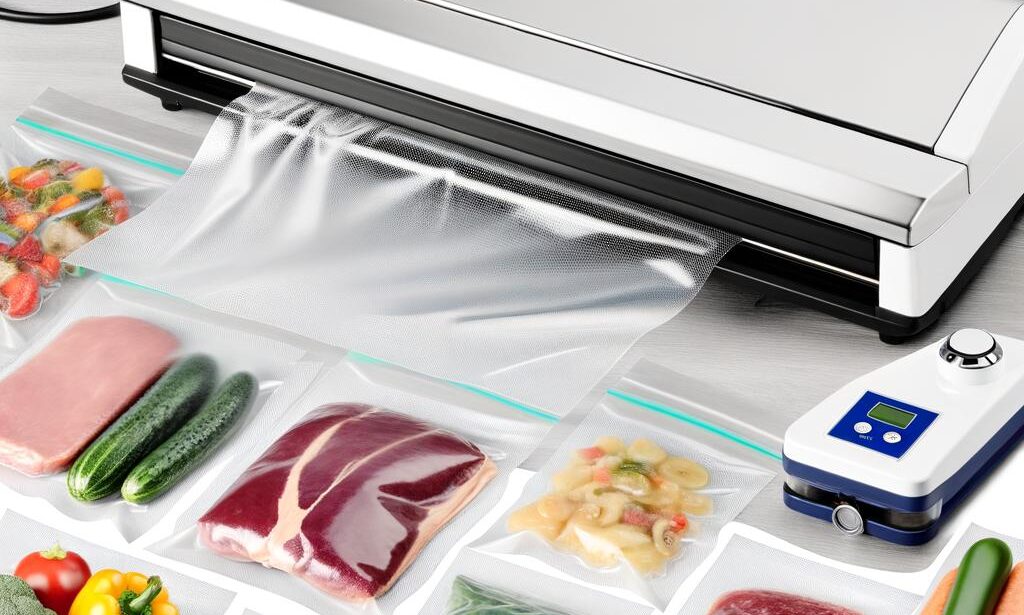In the quest to extend the shelf life of perishable goods and maintain their quality, vacuum sealing has emerged as a pivotal technology in both commercial and domestic settings. “Vacuum Sealing: The Science of Freshness Prolonged” delves into the mechanics and benefits of this preservation method, exploring how it slows down the deterioration of food products. By removing air from the packaging, vacuum sealing inhibits the growth of bacteria and mold, which require oxygen to thrive, and reduces the impact of oxidation on fats and flavors. This article will dissect the scientific principles behind vacuum sealing, examine its practical applications, and consider the implications for food safety, waste reduction, and the future of food storage. Join us as we unravel the intricacies of this modern approach to keeping our consumables fresher for longer.
Table of Contents
- The Benefits of Vacuum Sealing for Food Preservation
- Understanding the Role of Oxygen in Food Spoilage
- Choosing the Right Vacuum Sealer for Your Needs
- Tips for Properly Vacuum Sealing Foods
- Maximizing Freshness and Flavor with Vacuum Sealing Techniques
- Q&A
- To Wrap It Up

The Benefits of Vacuum Sealing for Food Preservation
Vacuum sealing is a revolutionary method for preserving food that has been gaining popularity in recent years. This process involves removing air from a package of food and sealing it tightly, which helps to extend the shelf life of the food and maintain its freshness for a longer period of time. There are several benefits to using vacuum sealing for food preservation, including:
- Extended Shelf Life: Vacuum sealing helps to prevent the growth of bacteria and mold by removing oxygen from the package, which can significantly extend the shelf life of the food.
- Preservation of Nutrients: By sealing food in a vacuum, the nutrients and flavors are better preserved, as exposure to air and moisture is minimized.
- Prevention of Freezer Burn: Vacuum sealing helps to prevent freezer burn by creating an airtight seal, which keeps the food fresh and free from ice crystals.
Overall, vacuum sealing is a highly effective method for food preservation that can help to reduce food waste and save money in the long run. Whether you are looking to extend the shelf life of fresh produce, meats, or leftovers, vacuum sealing is a practical and efficient solution for keeping food fresh for longer periods of time.

Understanding the Role of Oxygen in Food Spoilage
When it comes to , it’s important to recognize that oxygen is a key factor in the deterioration of food quality. Exposure to oxygen can lead to oxidation, which can cause food to spoil more quickly. This is because oxygen promotes the growth of aerobic bacteria, mold, and yeast, all of which can lead to food spoilage.
Vacuum sealing is a method that can help prolong the freshness of food by removing oxygen from the packaging. By creating a vacuum environment, the growth of aerobic bacteria, mold, and yeast is inhibited, which can help to extend the shelf life of food. This is because vacuum sealing helps to prevent oxidation and the degradation of food quality that can occur when food is exposed to oxygen.

Choosing the Right Vacuum Sealer for Your Needs
When it comes to preserving the freshness of your food, vacuum sealing is a game-changer. By removing air from the packaging, vacuum sealers help to prevent the growth of bacteria and mold, ultimately extending the shelf life of your food. However, with so many options on the market, it can be overwhelming to choose the right vacuum sealer for your needs. Here are some key factors to consider when making your decision:
- Sealing Power: Look for a vacuum sealer with strong suction power to ensure a tight seal and maximum freshness.
- Sealing Modes: Consider whether you need a vacuum sealer with multiple sealing modes, such as dry and moist, to accommodate a variety of foods.
- Bag Compatibility: Check if the vacuum sealer is compatible with different bag sizes and materials, such as pre-cut bags or rolls, to suit your specific packaging needs.
By taking these factors into account, you can find the perfect vacuum sealer to meet your food preservation needs and keep your ingredients fresh for longer.

Tips for Properly Vacuum Sealing Foods
When it comes to preserving the freshness of your food, vacuum sealing is a game-changer. By removing air from the packaging, vacuum sealing helps to prevent the growth of bacteria and mold, keeping your food fresh for longer periods of time. To ensure that you are properly vacuum sealing your foods, here are some tips to keep in mind:
- Use the Right Bags: Make sure to use bags specifically designed for vacuum sealing to ensure a proper seal.
- Remove Excess Air: Before sealing, make sure to remove as much air as possible from the bag to maximize freshness.
- Seal Properly: Ensure that the bag is properly sealed to prevent air from entering and compromising the freshness of the food.
By following these tips, you can make the most out of vacuum sealing and prolong the freshness of your food.

Maximizing Freshness and Flavor with Vacuum Sealing Techniques
Vacuum sealing is a technique that has been proven to be highly effective in preserving the freshness and flavor of food items. By removing the air from the packaging, vacuum sealing helps to prevent the growth of bacteria and mold, which can cause food to spoil. This process also helps to slow down the oxidation of food, which can lead to a loss of flavor and nutrients over time.
When it comes to , there are a few key factors to keep in mind:
- Choose the right vacuum sealer: Look for a high-quality vacuum sealer that is designed to effectively remove air from the packaging.
- Use the right packaging materials: Opt for vacuum sealing bags or rolls that are specifically designed for use with a vacuum sealer.
- Properly store the vacuum-sealed items: Make sure to store the vacuum-sealed items in a cool, dry place to further prolong their freshness.
By following these tips and techniques, you can ensure that your food items stay fresh and flavorful for longer periods of time, ultimately reducing waste and saving money in the long run.
Q&A
Q: What is vacuum sealing?
A: Vacuum sealing is a method of packaging food or other perishable items by removing air from the packaging before sealing it.
Q: How does vacuum sealing work?
A: Vacuum sealing works by using a vacuum sealer machine to remove air from the packaging, creating a tight seal that helps to preserve the freshness of the contents.
Q: What are the benefits of vacuum sealing?
A: Vacuum sealing helps to prolong the freshness of food by preventing the growth of bacteria and mold, as well as reducing the risk of freezer burn. It also helps to extend the shelf life of food and can save space in the refrigerator or freezer.
Q: What types of food can be vacuum sealed?
A: Vacuum sealing can be used for a wide variety of foods, including meats, fruits, vegetables, and even liquids such as soups and sauces.
Q: Are there any drawbacks to vacuum sealing?
A: While vacuum sealing can be a great way to preserve food, it may not be suitable for all types of food, such as delicate or soft items that can be crushed by the vacuum pressure.
Q: How long can vacuum sealed food last?
A: Vacuum sealed food can last significantly longer than food that is not vacuum sealed, with some items lasting up to five times longer in the refrigerator or freezer.
Q: Are there any safety concerns with vacuum sealing?
A: It is important to follow proper guidelines for vacuum sealing to ensure that food is safely preserved. This includes using appropriate packaging materials and storing food at the correct temperatures.
Q: Can vacuum sealing be used for non-food items?
A: Yes, vacuum sealing can also be used to preserve non-food items such as clothing, documents, and other household items.
To Wrap It Up
In conclusion, vacuum sealing is a scientifically proven method for prolonging the freshness of food. By removing air and creating a tight seal, vacuum sealing can help prevent the growth of bacteria and mold, ultimately extending the shelf life of your food. Whether you are a home cook looking to reduce food waste or a commercial kitchen seeking to preserve ingredients, vacuum sealing is a practical and effective solution. With a better understanding of the science behind vacuum sealing, you can make informed decisions about how to best preserve your food and reduce waste. So, next time you’re looking to keep your food fresh for longer, consider the benefits of vacuum sealing.

